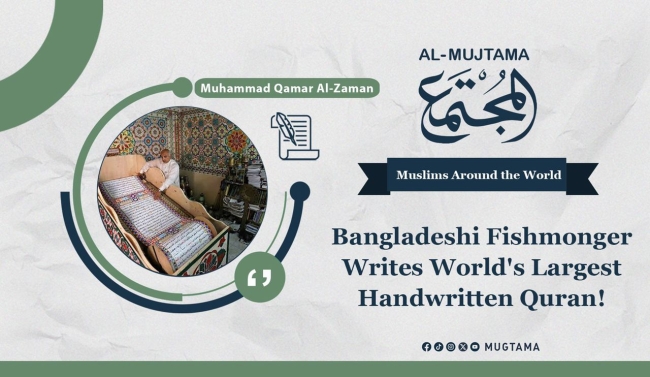Bangladeshi Fishmonger Writes World's Largest Handwritten Quran! Featured
Muhammad Habibur Rahman, a fisherman in the remote coastal area of Satkhira in southwest Bangladesh, has become known locally and internationally as the writer of the largest handwritten copy of the Quran in the world.
Located about 300 kilometers from the capital, Dhaka, Satkhira is one of the most climate-vulnerable areas in the country, frequently hit by tornadoes, floods, storms, and other natural disasters. This is where Habibur Rahman was born and raised.
In this remote area, fishing and agriculture are the main sources of livelihood for nearly 2.2 million people. However, rising salinity levels due to climate change have forced thousands to transition to other professions and migrate to Dhaka and other areas. To meet their basic needs and survive, most residents of the area must struggle greatly, with prevailing economic stagnation and soaring prices of daily commodities making their lives even more difficult.
In this environment lives Habibur Rahman, a young man with no formal education from any Islamic school. Yet he set the record for handwriting the largest copy of the Quran in the world through a journey that spanned years.
The Beginning of the Story
Habibur Rahman recounts: “After the Tahajjud (late-night prayer), I suddenly saw in a dream that I was offered to lead the prayer in the Grand Mosque. When I shared this vision with one of the scholars whom I trust, he said that Allah the Almighty may make me do something righteous. Indeed, after a few days, I began writing the Quran one night.”
With an emotional tone, he adds, “I never imagined that it would become the largest handwritten copy of the Quran in the world.”
A Massive Undertaking
Achieving this record in a remote village in Bangladesh was not easy by any means. It took 6 years, 8 months, and 23 days to complete this task. During this long journey, Habibur Rahman had to spend over one million takas (the local currency), approximately 10,000 dollars, to accomplish this mission. Additionally, he had to pay a monthly rent of 5,000 takas for a house to preserve this copy of the Quran.
Habibur Rahman said: “As an uneducated person, this seemed impossible to me, but I never lost hope. I relied on printed versions of six different Qurans, examining every letter from those printed copies before transcribing them into this handwritten Quran. I continued my work, spending nights and days with little rest.”
He added, “I was determined to finish this work at any cost because I believed that Allah had chosen me for this task. It was a great mercy from Allah for me. Yes, in writing, people usually say word by word, but in this Quran, it was letter by letter.”
The Quran’s Dimensions
The dimensions of this Quran are as follows: its length is 11 feet (335 cm), its width when closed is 8 feet (264 cm), and when fully opened, its width is 528 cm. It weighs 405 kg.
To write this copy of the Quran, 660 permanent markers in four colors were used. The margins were designed with the name of Allah, and the word “Allah” was used nearly 400,000 times. The total number of pages in the book is 142.
Display for Visitors
Habibur Rahman sometimes places the Quran in a nearby mosque for visitors to see. Local residents, as well as many people from various parts of the country, gather in Bilaspur to see the largest handwritten Quran with their own eyes. After viewing it, many express their excitement and gratitude to the writer for this effort, recognizing it as a world record in handwriting the Holy Quran.
Ahmed Shah Masoud, a resident of Bilaspur, remarked that they are fortunate to have such a record in their area. He mentioned that “many people around the world might learn about this largest handwritten Quran through the media, yet they can’t see and touch it directly, unlike us who are lucky to do so. When I think about it, I feel extremely emotional.”
People of all ages and places, traveling from distant areas, come to see the largest handwritten Quran. The population of Bangladesh (170 million), with its majority Muslim population, is deeply passionate about the Holy Quran. Despite not being highly educated, most of them have an innate love for religion, with the Quran holding the highest significance.
Among the visitors was Shahida Begum (80 years old), who came from a nearby village on foot just to see the largest handwritten Quran. She stood in a corner of the mosque, leaning on someone’s shoulder, gazing at the Quran without uttering a word. She expressed her joy, saying, “It was my pleasure to see such a large Quran. I feel very good seeing it. My heart is filled with peace now. It's a feeling I can't express in words.”
Global Exhibition
Habibur Rahman dreams of exhibiting this Quran in a way that allows people from all over the world to see it. This is why he has requested relevant authorities in Islamic countries such as Turkey, Egypt, or any Arab country to take this Quran and display it in their museums for easy viewing by the global community.
He said, “It must be placed in the right place for people to see. I have long wished for it to be preserved by any Arab country for the global exhibition.”
Local Muslim scholars also feel that such a Quran is a message to the world about the importance and honor of the Quran. If it is made available to people worldwide, it will attract them to study this holy book, thus playing a very effective role in spreading Islam.
Hafiz Muhammad Shahid al-Islam, the Imam of the mosque in Bilaspur, where Habibur Rahman occasionally places the handwritten Quran for display, said: “It is once again proven that Allah preserves this Quran, and I see another evidence of this through the work done by a young man in a remote area that was even beyond imagination.”
-------------------------------------------------------------
Read the Article in Arabic


